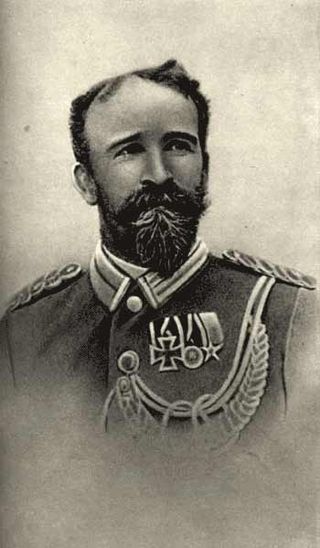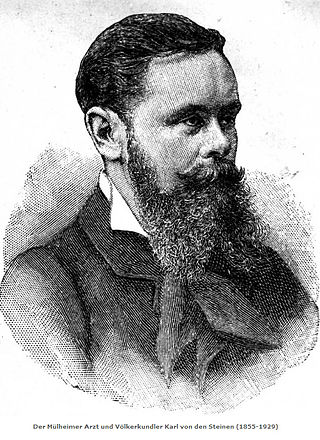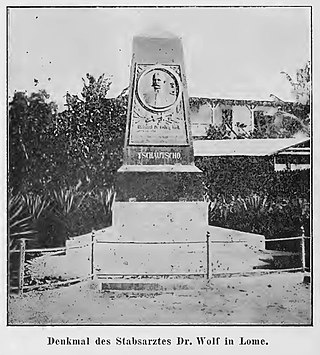Hans Tappenbeck (born 14 January 1861, Wolsier (today part of Havelaue), Western Havelland, Kingdom of Prussia; died 26 July 1889 in Douala, Cameroon) was a German officer and explorer of Africa.
Hans Tappenbeck (born 14 January 1861, Wolsier (today part of Havelaue), Western Havelland, Kingdom of Prussia; died 26 July 1889 in Douala, Cameroon) was a German officer and explorer of Africa.
Tappenbeck was born as son of a Domänenpächter (tenant of an estate) and Oberamtmann (senior bailiff). He attended the Louisenstädtische Gymnasium in Berlin and the Cadet Corps in Kulm (Chełmno). He entered the 4th Westphalian Infantry Regiment No 17 as Portepee-Fähnrich (ensign with sword-knot). In 1880 he received his officer's commission.
Between 1884 and 1886 Tappenbeck explored the Congo region. In 1887 he was commissioned jointly with Richard Kund for the exploration of the back-country of Cameroon. His first advance was in November 1887, via Bipindi to the Nyong River until over the Sanaga River. Military important was primarily the conquest by force of Wataré, a sub-center of the Vute tribe.
In a second expedition together with Kund he founded in the territory of the Ewondo the station "Jaunde", from that the present capital of Cameroon Yaoundé emerged. The station was used primarily for scientific research, exploration of the flora and fauna in terms of economic exploitation, and as a base for further geographical expeditions. E.g., from this base Tappenbeck advanced as first Europeaon to the residence of Ngrang Gomtsé in Ndumba, the at that time most influential reign of the Vutes. With the foundation of Junda, that he – contrary to the instructions he had received from the Foreign Office – made significantly nearer to central Cameroon than planned, he quasi prepared an effective occupation of the back-country.
On the march returning to the coast, Tappenbeck died of malaria.

Yaoundé is the capital of Cameroon and, with a population of more than 2.8 million, the second-largest city in the country after the port city Douala. It lies in the Centre Region of the nation at an elevation of about 750 metres (2,500 ft) above sea level.

Karl Hermann Johannes Thiele was a German zoologist specialized in malacology. Thiele was born in Goldap, East Prussia. His Handbuch der systematischen Weichtierkunde is a standard work. From 1904 until his retirement in 1925 he was the curator of the malacological collection at the Museum für Naturkunde in Berlin. Thiele described more than 1.500 new species of molluscs; until today their types are deposited with the Museum of Natural History in Berlin. Especially important are his works on the Mollusca of the First German Antarctica Expedition and of the German Deep Sea Expedition aboard the vessel Valdivia.

Helmut Hasse was a German mathematician working in algebraic number theory, known for fundamental contributions to class field theory, the application of p-adic numbers to local class field theory and diophantine geometry, and to local zeta functions.

Didyma was an ancient Greek sanctuary on the coast of Ionia in the domain of the famous city of Miletus. Apollo was the main deity of the sanctuary of Didyma, also called Didymaion. But it was home to both of the temples dedicated to the twins Apollo and Artemis. Other deities were also honoured within the sanctuary. The Didymaion was well renowned in antiquity because of its famed oracle. This oracle of Apollo was situated within what was, and is, one of the world's greatest temples to Apollo. The remains of this Hellenistic temple belong to the best preserved temples of classical antiquity. Besides this temple other buildings existed within the sanctuary which have been rediscovered recently; a Greek theatre and the foundations of the above-mentioned Hellenistic temple of Artemis, to name but two.

Eduard von Martens also known as Carl or Karl Eduard von Martens, was a German zoologist.

Curt Karl Bruno von François was a German geographer, cartographer, Schutztruppe officer and commissioner of the imperial colonial army of the German Empire, particularly in German South West Africa where he was responsible on behalf of Kaiser for the foundation of the city of Windhoek on 18 October 1890 and the harbor of Swakopmund on 4 August 1892.

Hermann Wilhelm Leopold Ludwig Wissmann, after 1890 Hermann von Wissmann, was a German explorer and administrator in Africa.

Albert Grünwedel was a German Indologist, Tibetologist, archaeologist, and explorer of Central Asia. He was one of the first scholars to study the Lepcha language.

Karl Oenike (1862–1924) was a German landscape painter, who participated in various scientific expeditions in South America during the years 1887–1891 as painter and photographer. He wrote detailed diaries and made drawings, sketches, watercolors, oil paintings and photos during these expeditions, which give a valuable perspective of remote regions and populations, and of the difficulties encountered by German explorers in the 1880s. Few artists in the exotic art genre have depicted better the "magic of the forest" in his paintings.

Karl von den Steinen was a German physician, ethnologist, explorer, and author of important anthropological work, which is particularly to the study of Indian cultures of Central Brazil, and the art of the Marquesas. He laid the permanent foundations for Brazilian ethnology.
Oskar Alexander Richard Büttner was a German botanist and mineralogist who was involved in the exploration of the Congo Basin.
Franz Xaver Rudolf von Höhnel was an Austrian bryologist, mycologist, and algologist, brother of explorer Ludwig von Höhnel (1857–1942). He obtained his PhD in Strasbourg in 1877, and was a professor of botany in the Vienna University of Technology from 1884 to 1920. Höhnel described roughly 250 new genera and 500 species of fungi, and was known for his contributions to the taxonomy of the Coelomycetes. He died in Vienna on November 11, 1920.
Paul Reichard was a German explorer who traveled extensively in the African continent. His discoveries led to the establishment of the German East Africa Protectorate.
Tall Munbāqa or Mumbaqat, the site of the Late Bronze Age city of Ekalte, is a 5,000-year-old town complex in northern Syria now lying in ruins. The ruins are located on a steep slope on the east bank of the upper course of the Euphrates. In the 3rd and 2nd millennium BC the city was an important city-state in the region. Due to the establishment of the Tabqa Dam at Al-Thawrah, 35 kilometers west of Raqqa, the city ruins are partially flooded today by Lake Assad. Situated high above the steep drop of the eastern shore, Tall Munbāqa is still preserved. The Bronze Age site of Tell Hadidi (Azu) lies 5 kilometers to the north. The city-god of Ekalte was Baʿlaka. There are known to have been four temples in the city, three on the high ground by the Euphrates and one at a city gate.
Julius Döring was a Baltic German painter, drawing teacher, historian, archaeologist, librarian and museum worker.
Leonhard Sigmund Friedrich Kuno Klaus Schultze-Jena was a German explorer, zoologist, and anthropologist known for his explorations of German Southwest Africa and New Guinea, as well as for his studies on Mesoamerican languages. During the Herero and Namaqua genocide, Schultze, a witness, took "body parts from fresh native corpses" which according to him was a "welcome addition". He also noted that he could use prisoners for that purpose.
Hans Schmidt was a German musicologist.

Heinrich Ludwig Wolf was a German doctor and anthropologist.

Bismarckburg was a colonial station in the German colony of Togo. It was named after the founder of the German empire, Otto von Bismarck.

Hans Gustav Ferdinand Ramsay, from 1911 von Ramsay was an officer in the Imperial German Army and explorer of Africa.